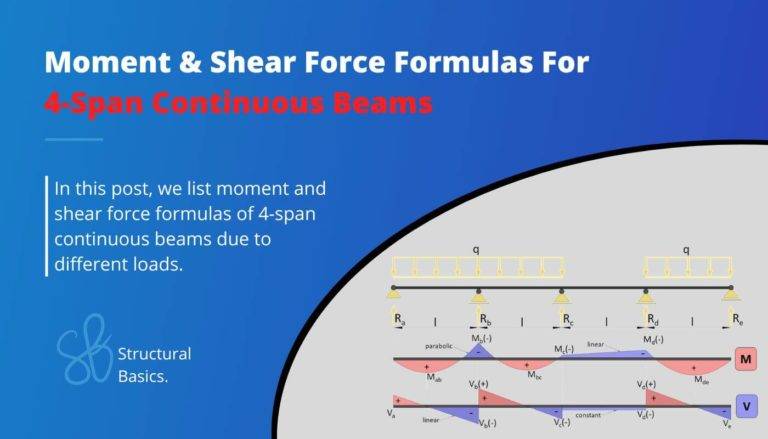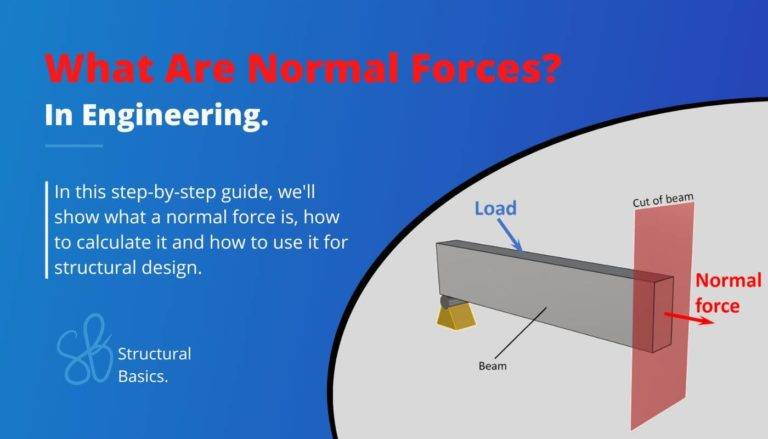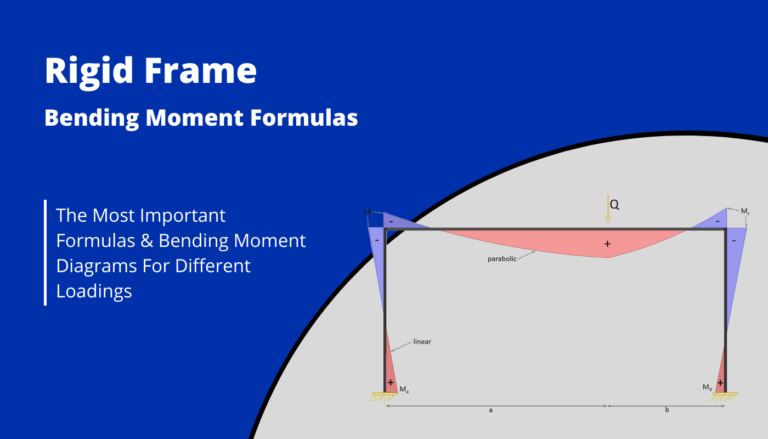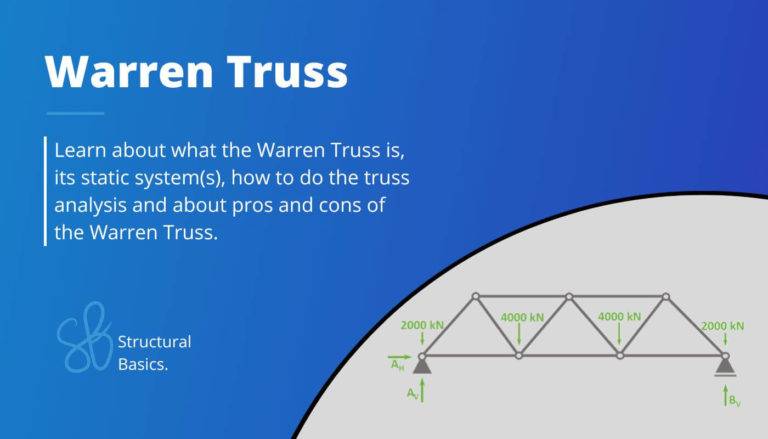What is The Scissors Truss? And How Does It Work?
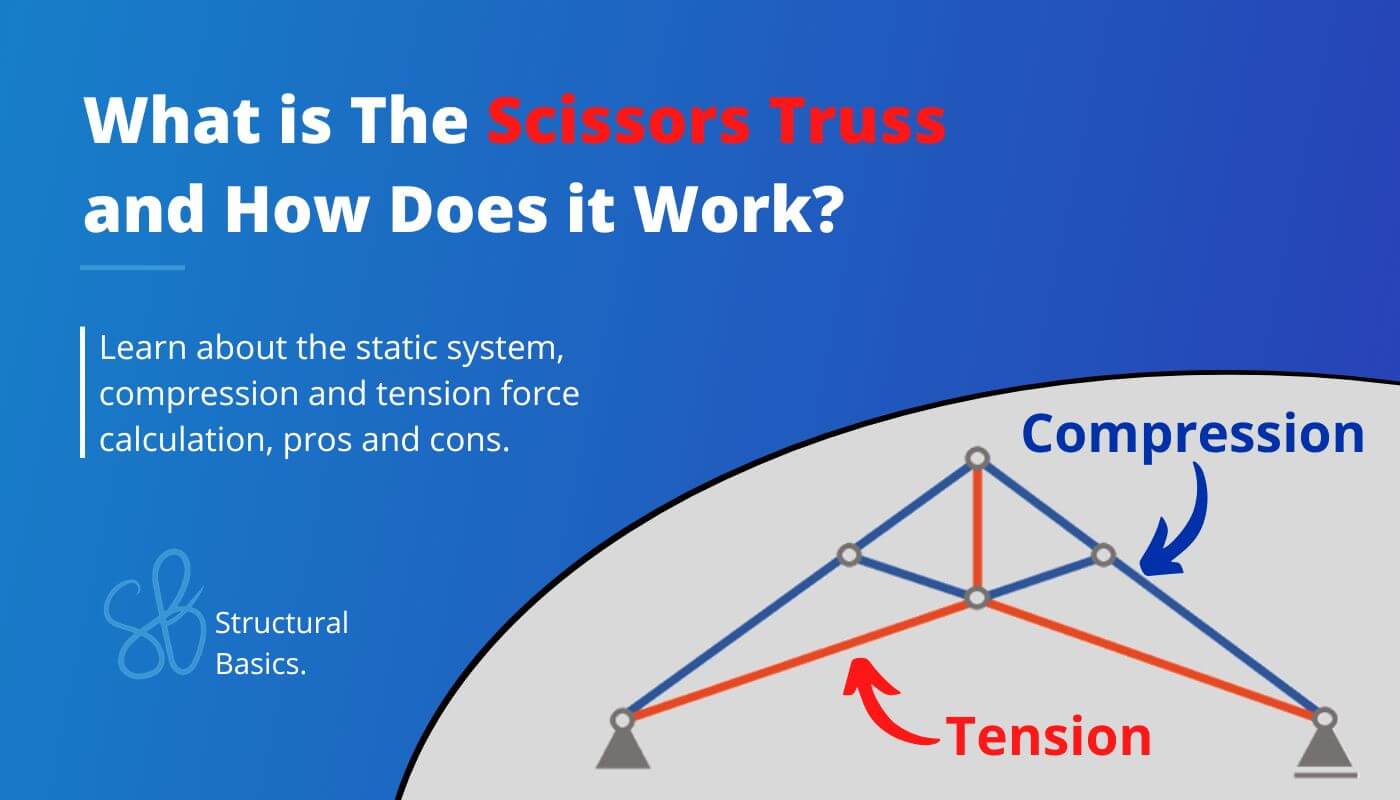
Do you often feel restricted by traditional building designs? Do you dream of a home with soaring ceilings, open spaces, and a unique architectural feature that sets it apart?
Then you may want to consider a Scissors Truss. Scissors Trusses offer a solution to the problem of limited interior volume and boring building designs.
They agitate by creating a sense of longing for a more dramatic and visually appealing interior space. By incorporating a Scissor Truss into your design, you’ll add a unique zigzag shape, increased interior volume, and longer spans to your home.
In this blog post, we’ll take a closer look at the Scissors Truss and explain their key features, benefits, common uses and go through a calculation example, step-by-step.
Alright, let’s talk SCISSORS TRUSSES. 🚀🚀
What Is a Scissors Truss?
The scissors truss is a type of truss structure where the bottom chords are inclined, connecting to the rafters. This is quite uncommon. In most other trusses, the bottom chords are horizontal. Scissor trusses are mainly used for roof structures.
Let’s have a look at the Scissor Truss and its members.⬇️⬇️
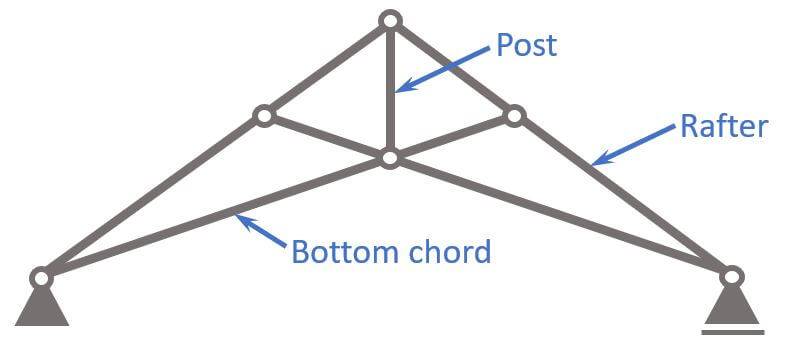
- Rafter
- Posts
- Bottom chord
What is the Scissors Truss used for?
Scissor trusses are mainly used as roof structures of
- Sheds or
- in general, when roof structures with a higher/vaulted ceiling are required.
In most cases, timber is the main material, however steel could also be an option.
Let’s look at the static system to get a better understanding of the structural behaviour of this truss type.🚀🚀
Static System
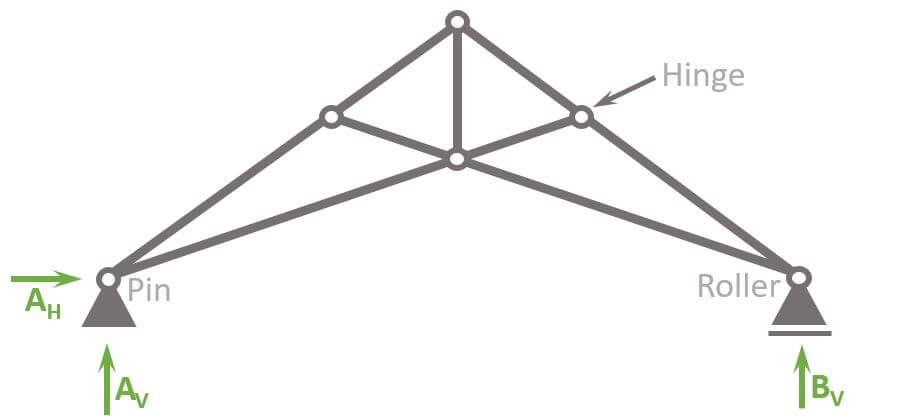
The static system of the Scissors Truss is characterized by having
- hinge connections at all nodes
- a pin and roller support, which makes the system statically determinate. Therefore, the internal forces can be calculated with the 3 equilibrium equations.
Hinges
Most truss structures are designed with hinge connections, mainly due to 2 reasons:
- Easier to calculate: Trusses with hinge connections make the structure statically determinate, which means that the internal forces can be calculated by hand. Especially until advanced Finite element software programs weren’t widely available, this was the main reason for using hinge connections. If fixed connections are used, but no software is available, advanced methods like the method of consistent deformation can be used. However, these methods are complicated and susceptible to calculation failures.
- Cost: Hinge connections are cheaper to build than fixed connections.
It definitely makes sense to be aware of the differences of a truss with hinges and fixed connections. In the picture above, you can see the “normal” scissors truss with hinge connections.
We also summarize the characteristics of the truss with fixed connections and a mix of fixed and hinge connections a bit further below.
Characteristics
Loads
In most cases, the scissors truss is used as a roof structure, where dead, snow, wind and live loads are applied on the rafters.
Support types
1 Pin and 1 Roller support
Reactions
Pin support: Horizontal AH and vertical reaction force AV
Roller support: Vertical reaction force BV
Connection types
Hinge connections: Moment is 0 in hinge connections.
Scissors Truss with fixed connections
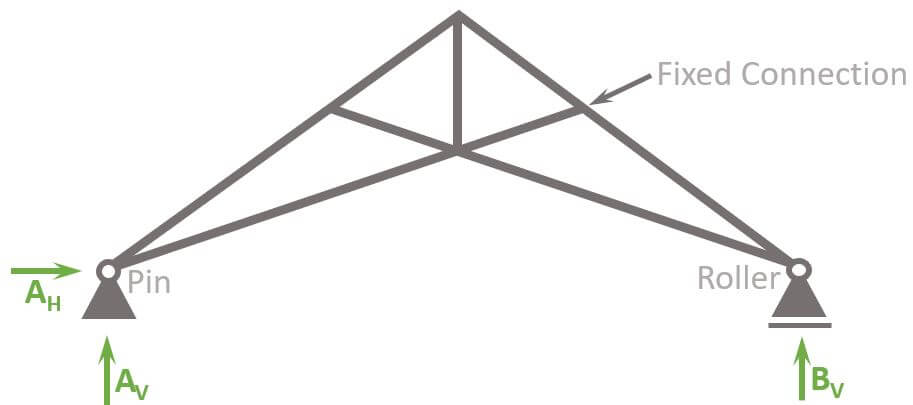
The Scissors truss with fixed connections has the following differences to hinge connections:
- Bending moments in the connections
- More rigidity -> more robustness
- Smaller vertical deflection
Scissors Truss with fixed and hinge connections
The most realistic static system is actually a mix of fixed and hinge connections.
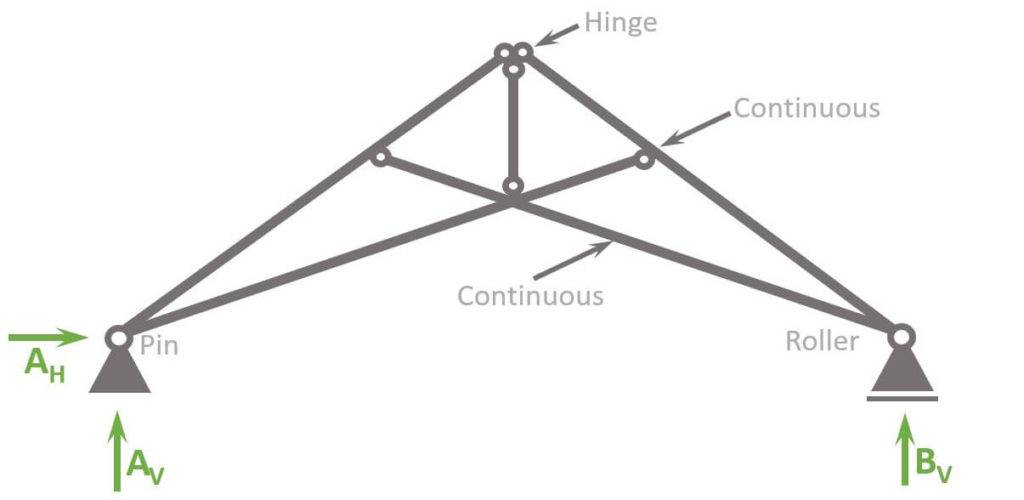
So why is this the most realistic static system?
It’s because usually the rafters and bottom chords are delivered in one piece, meaning that they are constructed continuous and the post is attached to them.
The rafters basically turn into a 2-span continuous beam, which means that the static system is no longer statically determinate.
This means that advanced methods with FE programs need to be used to calculate the internal forces like Moment, Normal and Shear forces.
Alright, now that we have learned how to set up our static system, we are ready to calculate the internal compression and tension forces of the statically determinate truss.🎉🎉
Scissors Truss Analysis
Let’s say our Scissors Truss is a roof structure. Therefore, the truss is exposed to the snow load only on the rafters.
We also simplify and say that the load is 2 kN/m. This equals a snow load of 1 kN/m2 and a truss spacing of 2m. Check out this article to learn more about the snow load.
$$1 kN/m^2 \cdot 2m = 2 kN/m$$
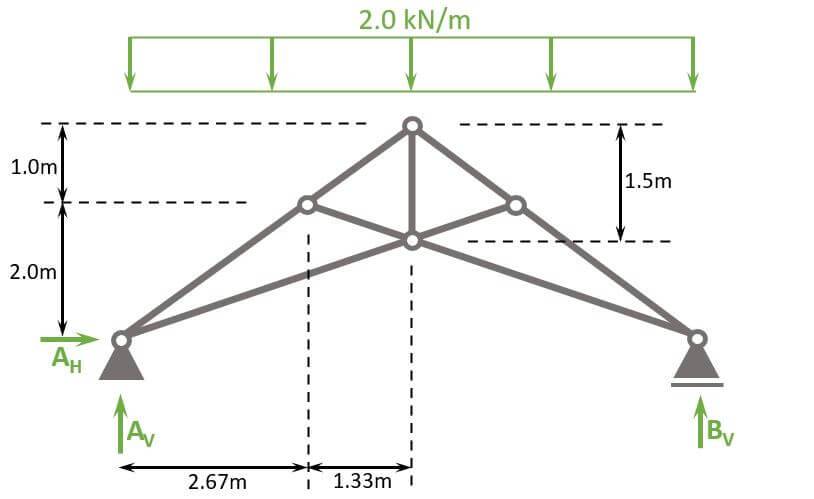
Before we start with the calculations, let’s give the nodes 🔵 and bars 🔴 some indices, so the identification is easier later in the internal force calculation.
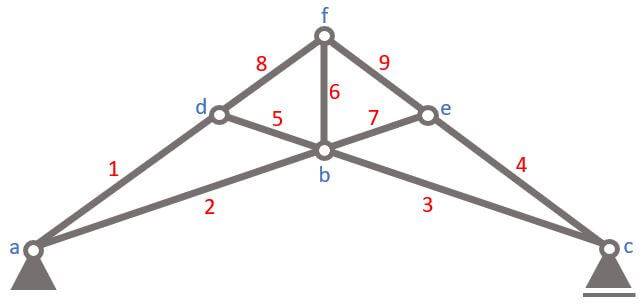
To calculate the compression and tension forces of the truss members with the 3 equilibrium equations, we do another approximation.
The Line load of 2 kN/m is approximated as point loads⬇️ in the nodes, because otherwise the rafters would be beams instead of bars, which makes the calculation a lot more difficult.
The point load applied to nodes (a) and (c) is calculated as
$$2 kN/m \cdot \frac{2.67m}{2} = 2.67 kN$$
❗But be careful. The point loads are only transformed like this for the snow load. Dead, wind and live load are applied differently. Check out our article about how to apply loads to roofs.
The point loads applied to nodes (d) and (e) are calculated as
$$2 kN/m \cdot (\frac{2.67m}{2} + \frac{1.33m}{2}) = 4.0 kN$$
and the point load applied to (f) is calculated as
$$2 kN/m \cdot 1.33m = 2.66 kN$$
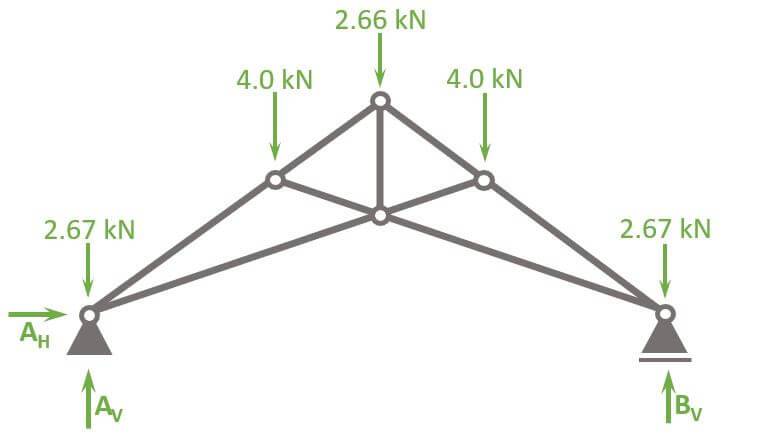
Let’s calculate. 🚀🚀
Calculation of Reaction Forces
As the structure is statically determinate, the reaction forces can be calculated with the 3 Equilibrium equations.
In our case, we are calculating the support forces AH, AV and BV.
$\sum H = 0: A_H = 0$
$\sum V = 0: A_V + B_V \, – 2 \cdot 2.67 \, \mbox{kN} \, – 2 \cdot 4.0 \, \mbox{kN} – 2.66 \, \mbox{kN}= 0 $ -> $A_V = B_V = \frac{2 \cdot 2.67 + 2 \cdot 4.0 + 2.66}{2} \mbox{kN} = 8 \mbox{kN}$
$\sum M = 0: M_a = 0$
Calculation of the internal forces
Node a
Alright, now that we know the reaction forces, we can calculate the normal force of the first bar elements 1 and 2.
To do that, we only look at node (a) and its point loads/normal forces AV, 2.67 kN, N1 and N2.
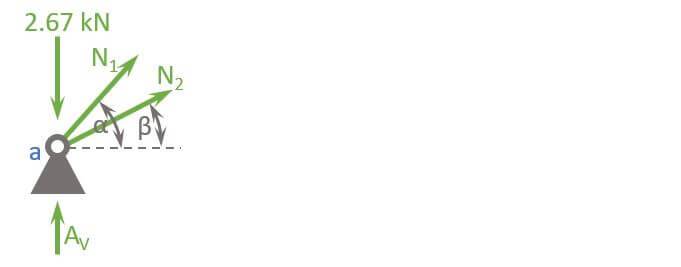
$$\alpha = atan(\frac{1.5m}{4m}) = 36.9° $$
$$\beta = atan(\frac{3m}{4m}) = 20.6° $$
Vertical Equilibrium:
$$ \sum V = 0: A_v – 2.67 kN + N_1 \cdot sin(\alpha) + N_2 \cdot sin(\beta) = 0$$
Let’s solve that for N1.
$$ N_1 = \frac{2.67 kN – 8 kN – N_2 \cdot sin(\beta)}{sin(\alpha)}$$
💡💡 We can’t solve this equation because we have 2 unknowns ($N_1$ + $N_2$). Therefore, we need another equation where we isert $N_1$.⬇️⬇️
Horizontal Equilibrium:
$$\sum H = 0: N_1 \cdot cos(\alpha) + N_2 \cdot cos(\beta) = 0$$
Let’s solve that for N2.
$$\frac{2.67kN – 8kN – N_2 \cdot sin(\beta)}{sin(\alpha)} \cdot cos(\alpha) + N_2 \cdot cos(\beta) = 0$$
$$\frac{-5.33kN}{tan(\alpha)} – N_2 \cdot \frac{sin(\beta)}{tan(\alpha)} + N_2 \cdot cos(\beta) = 0$$
$$N_2 \cdot (-\frac{sin(\beta)}{tan(\alpha)} + cos(\beta)) = \frac{5.33 kN}{tan(\alpha)}$$
$$N_2 = \frac{5.33 kN}{(-\frac{sin(\beta)}{tan(\alpha)} + cos(\beta)) \cdot tan(\alpha)} = 15.18kN$$
Now, let’s insert N2 into Equation 1.
$$N_1 = \frac{2.67 kN – 8 kN – N_2 \cdot sin(\beta)}{sin(\alpha)} = -17.77kN$$
Node d

$$\alpha = 36.9° $$
$$\gamma = atan(\frac{0.5m}{1.33m}) = 20.6° $$
Vertical Equilibrium:
$$ \sum V = 0: -N_1 \cdot sin(\alpha) + N_8 \cdot sin(\alpha) – N_5 \cdot sin(\gamma) – 4kN = 0$$
Let’s solve that for N5.
$$ N_5 = – N_1 \cdot \frac{sin(\alpha)}{sin(\gamma)} + N_8 \cdot \frac{sin(\alpha)}{sin(\gamma)} – \frac{4 kN}{sin(\gamma)}$$
💡💡 We can’t solve this equation because we have 2 unknowns ($N_5$ + $N_8$). Therefore, we need another equation where we insert $N_5$.⬇️⬇️
Horizontal Equilibrium:
$$\sum H = 0: -N_1 \cdot cos(\alpha) + N_8 \cdot cos(\alpha) + N_5 \cdot cos(\gamma) = 0$$
$$-N_1 \cdot cos(\alpha) + N_8 \cdot cos(\alpha) + (- N_1 \cdot \frac{sin(\alpha)}{sin(\gamma)} + N_8 \cdot \frac{sin(\alpha)}{sin(\gamma)} – \frac{4 kN}{sin(\gamma)}) \cdot cos(\gamma) = 0$$
$$-N_1 \cdot cos(\alpha) + N_8 \cdot cos(\alpha) – N_1 \cdot \frac{sin(\alpha)}{tan(\gamma)} + N_8 \cdot \frac{sin(\alpha)}{tan(\gamma)} – \frac{4 kN}{tan(\gamma)} = 0$$
Let’s solve that for N8.
$$N_8 \cdot (cos(\alpha) + \frac{sin(\alpha)}{tan(\gamma)}) = N_1 \cdot cos(\alpha) + N_1 \cdot \frac{sin(\alpha)}{tan(\gamma)} + \frac{4 kN}{tan(\gamma)} = 0$$
$$N_8 = \frac{N_1 \cdot cos(\alpha) + N_1 \cdot \frac{sin(\alpha)}{tan(\gamma)} + \frac{4 kN}{tan(\gamma)}}{cos(\alpha) + \frac{sin(\alpha)}{tan(\gamma)}} = -13.33kN$$
Now, let’s insert N8 into Equation 1.
$$N_5 = – N_1 \cdot \frac{sin(\alpha)}{sin(\gamma)} + N_8 \cdot \frac{sin(\alpha)}{sin(\gamma)} – \frac{4 kN}{sin(\gamma)} = -3.8 kN$$
Node f
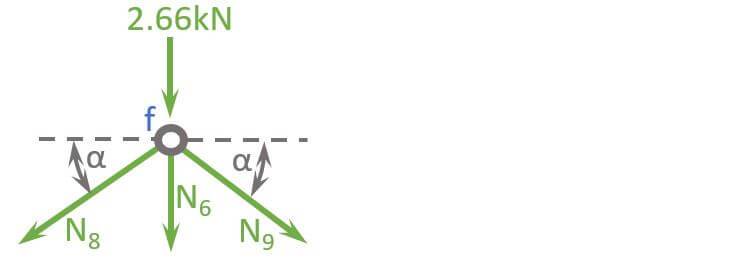
$$ \alpha = 36.9° $$
Vertical Equilibrium:
$$ \sum V = 0: 2.66 kN + N_6 + 2 \cdot N_8 \cdot sin(\alpha) = 0$$
💡💡 We can write $2 \cdot N_8$ because N8 = N9 due to symmetry.
Let’s solve that for N6.
$$ N_6 = -2.66 kN – 2 \cdot N_8 \sin(\alpha) = 13.33 kN$$
Well done! Now we have calculated the normal forces of ALL bars.🎉🎉
What all? But we are missing half of the bars.
Yes! But due to symmetry we know that N1 = N4, N2 = N3, N5 = N7, N8 = N9.
So, to summarize it, a normal force diagram helps to understand how the loads travel through the truss.
Normal force diagram
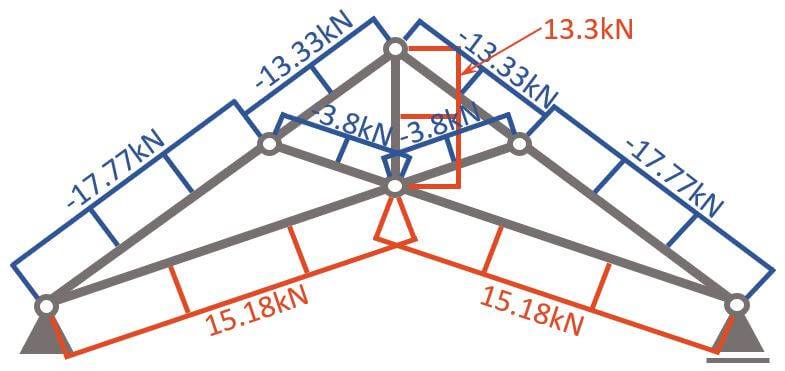
Compression and Tension Members
Now, as you can see in the normal force diagram, some members have a positive (+) and some have a negative (-) normal force.
A negative (-) normal force means that the member is under compression 🔵, while a positive (+) normal force means that the member acts in tension 🔴.
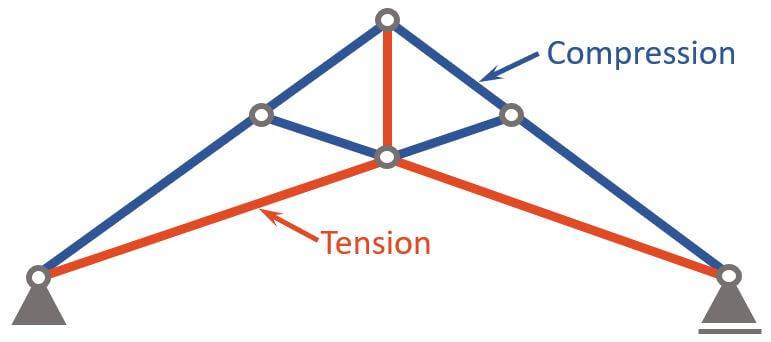
Advantages and Disadvantages
Pros
- Aesthetically pleasing structures: unique and attractive appearance
- Scissors trusses create more height in a room due to the inclination of the bottom chords
- Span: The scissors truss can span longer than other types
Cons
- Limited height of the rafters
- Cost: The cost might be higher due to the complexity of scissors trusses
However, the pros and cons depend on many factors and can vary for each structure or location.
Conclusion
Now, that you got an overview of the Scissors Truss, and how we calculate its internal forces, you can learn about loads, because every truss is exposed to loads.
Because there are always multiple loads acting on Scissors Trusses, considering these different loads in the structural design is done by setting up Load Combinations with safety factors.🦺
Once all load cases and combinations are set up, the structural elements can be designed. We have already written a guide on how to design a timber truss. Check it out!
If you want to learn more about trusses, make sure to read our guide on the different types of trusses.
I hope that this article helped you understand the Scissors Truss and how to go further from here. In case you still have questions.
Let us know in the comments below ✍️.
Scissors Truss FAQ
A Scissors Truss is a type of truss that is characterized by its zigzag shape, which creates a dramatic and attractive interior volume. It is mostly used in roof structures.
The benefits of using a Scissors Truss include increased interior volume (more room height than other trusses), aesthetic appeal, and the ability to span longer distances than other truss types.
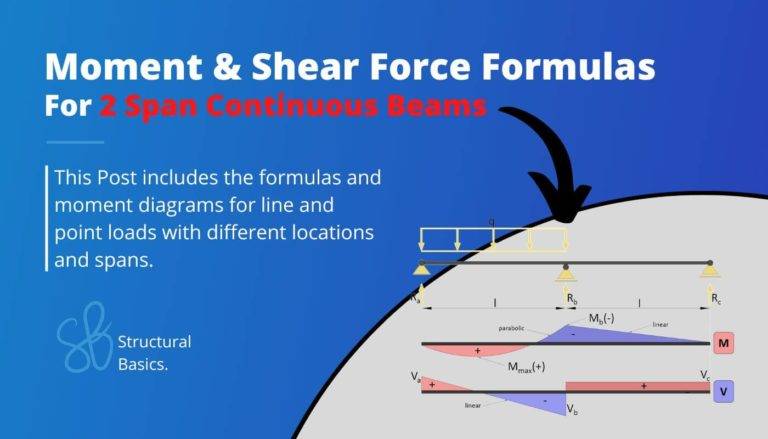
![Understand Shear Forces [An Engineering Explanation]](https://www.structuralbasics.com/wp-content/uploads/2023/07/Shear-force-768x439.jpg)
